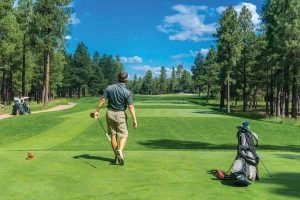
Golf Injuries and Physiotherapy
Golf Injuries and Physiotherapy

However, golf can be very demanding; requiring strength, endurance, explosive power, flexibility and athletic ability to perform a movement that produces some of the fastest club head and ball speeds of any sport.
The effect of these repeated large forces on the body can lead to many different types of injuries, which are often specific to certain areas and sides of the body in golfers, depending on their lead side.
Much research has been done on the types and likelihood of injuries experienced by golfers with the main areas of the body prone to injury being;
- The lower back,
- The neck, shoulder, elbow, wrist
- The Hips
Lower back injuries account for roughly 30% of all golfing injuries, with poor technique and lack of flexibility in the mid spine and hips possible causes. Often it presents as an aching and discomfort on moving into certain positions and doing certain activities. However, the soreness and stiffness that people often present with is called ‘non specific’ as it is not usually clear which structure is causing the problem/pain.
Golf requires much more athletic ability than many imagine and the consequences of this mean many people suffer injuries through poor general conditioning, lack of warm up, poor technique and practice and playing habits.
The neck, shoulder, arms and the hips – Usually they are the last point of reference in a golf swing, because often these parts are forced to compensate for what the rest of the body is not doing properly.
Golf Treatment
- Soft tissue release/massage
- Specific joint mobilisation and manipulation.
- Electronic muscle stimulation
- Exercise to work on strengthening:
- Upper limbs
- Core Muscle stability
- Thoracic and Lumbar spine
- Hip Joints
- Lower back
- Gluteal and pelvic floor
- Rehabilitation exercises that are individualised to the golfer’s body type, swing mechanics and likes and dislikes.
With regular conditioning, improvement in technique, warm ups and structured practice the improvements in a golfer’s performance and reduction in injuries can be significant. Your physiotherapist can help you with this as well as provide you with effective treatment should you suffer with any injuries.
Golf Injury Prevention
Swing correction and warming up before golf has been shown to decrease injuries. There are specific ranges of motion that a golfer should be able to attain. Your Duncraig Physio can provide you with a golfer physical screen that assesses your body’s range of motion, strength etc and provide you with exercises to correct any deficits. They will help optimise your body to best suit your golf swing and body’s limitations.